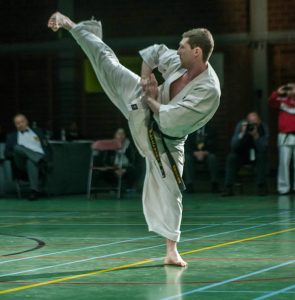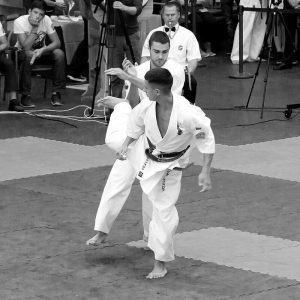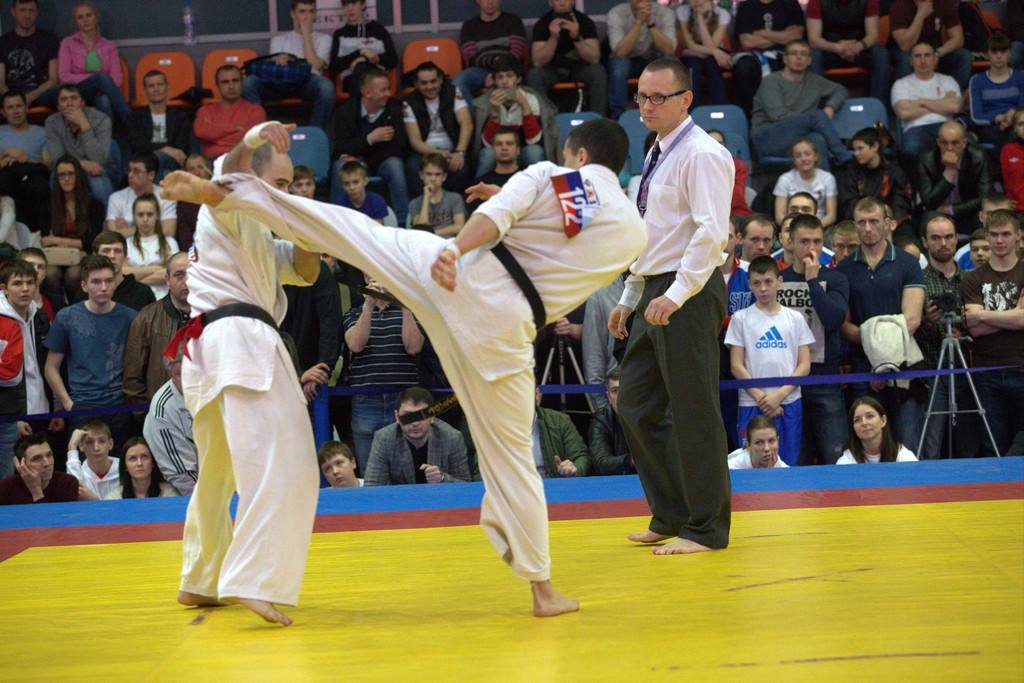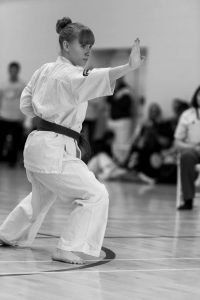This is a question I pose, and I do not propose to have the answer. When Sosai Mas Oyama created Kyokushin, he created it to be the ultimate martial art at its time, combining the base he had in Judo, Shotokan, Goju-ryu and Taikiken.

Kyokushin was built on hard practice, strengthening the mind and body, through perseverance, with a foundation of Kihon, Kumite and Kata.
I know many argue that Kata is useless, that the only way it can work is with diligent practice and breakdown of the bunkai, or application, and even then the jury is out on it’s effectiveness. However, it also imparts the practice of proper form, transitioning, distribution of power through torque and hip movement. It teaches Kime and focus. It has many attributes that improve the martial artist.
It is true you can be a fantastic fighter without kata. Look at Kickboxing as a prime example, but it isn’t Kyokushin. Though much of modern kickboxing (Dutch style, K1) was built with Kyokushin principles and foundation.
However, there is a movement in certain areas and organizations to remove Kihon and Kata training from Kyokushin all together, or not practice it or use it as a grading requirement. There are high-ranking black belts in Kyokushin who do not know basic Kyokushin kata. Are they still Kyokushin?
Historically, all the great Kyokushin champions knew and practiced kata, Matsui, Midori, Kazumi, Filho, etc, and they continue to teach and practice Kata today. But it seems sometime after the passing of Sosai, kata practice in some groups and areas fell out of practice, with the focus on fighting.
Sure, they can be fantastic fighters, but are they Kyokushin? What constitutes Kyokushin? Is Kyokushin only a philosophy, or is it also an amalgamation of the physical components of Kihon, Kata and Kumite? Or both physical and philosophical?
What would Sosai Mas Oyama say about the situation if he were still alive?
For myself, Kata training is important for varied of reasons.
Body conditioning (stance training), mental awareness including; zanshin (relaxed awareness), fudoshin (composure), mushin (no mind), shoshin (open mind), kensho (insight), health, visualization, proper form and technique, control, proper hip rotation, and the list goes on.
For an instructor it helps with transmission of knowledge and student goal setting, as kata take a long time to learn and contain a systematic way to evolve.
And finally, unlike kumite, kata can be practiced and performed throughout your life, well into your senior years. It is rare to see seniors kickboxing and fighting, perhaps a little light sparring, but you will find many masters of karate still working, perfecting and deriving meaning from kata practice well into their 80s.
For myself, without kata, karate loses it’s “martial art” and becomes a combat sport like kickboxing, boxing and wrestling. Not that there is anything wrong with that, but for myself, there is something missing and I am not sure if I still call it Karate Kyokushin.
Osu!
Tensho Kata led by Shihan David Pickthall (IFK Vice-President)


What is the social utility of a fight with no real combat? What is the social meaning of a martial art that will not protect you in a real brawl? There are fighters, and there are diletants – gnostic black-belts full of knowledge – and uncapable of defending themselves in a real fight. Kata is useless. As people say here, “everybody can do it”. Kata is a dangerous ilusion. All martial arts in Japan, after the II Great war, were castrated. Emasculated to avoid violence in a defeated country. I learned jiu-jitsu between 1962 and 1967. It’ powerful and real.… Read more »
Someone that is conditioned in Kyokushinkai and has real sparring practice (Kumite) will have 90% of what you meet on the street beat when it comes to a fight. Remember, Sosai Mas Oyama said it mainly comes down to a test of stamina. A karateka has 1000% times the stamina of your average bar brawler. So the whole “is it applicable in a street fight” argument is ridiculous. I suggest those wishing to dilute martial ARTS with that mentality to carry a 6 shooter on their sides, jump on a tread mill 30 mins a day, and give up the… Read more »
Osu Shihan
Thank you for the information that you have provided us. Kindly use this e-mail. skura.mtshongwana@gmail.com
The reason I say “re-engineered” is because a lot people have mad bunkai too complicated and by saying a blocks are locks, throws etc. and then they show intricate moves that won’t work in fighting.
In regards to the original question, “is Kyokushin Karate style Kyokushin within Kata”, I would say yes. Most of what we practice and the way we practice, fight, etc. is recent. Some of the Knockdown groups practice traditional Kata and some don’t. Kyokushin and it’s offshoots exist because of the Kumite.
I do agree with you that Kata are a “dictionary” of techniques. Sensei Antony is a black belt in Shotokan and BJJ. So, I am sure he has incorporated into his system of Karate Jutsu. Most instructors have incorporated other arts because martial arts are always evolving and certain arts specialize. Yes, Karate and techniques from any style can be effective in fighting. It will depend on the fighter of course. But no fighter trains Kata to get ready for a fight. They spar. Traditional Karate technique and Kata are based on martial combat (fighting). Karate was spread through Kata… Read more »
I want to share a video that shows Karate applied (throwing, grappling, and MMA) through sport. These are some of my students and how we apply Karate. This is from the European Championships.
https://www.youtube.com/watch?v=yOzRz2G3r9c
Scott, First of all, the highlights are from various combat sports (boxing, kickboxing, muay thai, TKD, and MMA), not just stand up fighting. I am also a Judoka. You an look through my Youtube channel and Shidokan Atlanta dojo members competing in every style of combat sports (BJJ, MMA, Judo, and all of the stand). I am familiar with the guys in the clip you put up and they have a lot of good material. But like many other bunkai specialist, they have cross trained (in styles other than Karate) and modified Kata techniques to mimic MMA techniques. A lot… Read more »
The question put in this topic is NOT which is better (kata or kumite) for fighting. Of course, Kumite is like going to a foreign country to learn a language, which is far better than learning a foreign language from your desk. You can depart straight away without knowing any word, but I prefer to learn gradually, systematically. Kihon is always good for conditioning, especially the way we do here, which one can call it “Power Kihon”, putting every energy you have in every single blow of kick, and that for hundres of it. Kata than is also good for… Read more »
Kumite will give the Karateka a chance of handling the sucker punch, etc. a lot better than Kata practice because one will be used to contact, pressure, and stress. Through competition one learns how to deal with pain, pressure, etc. I would put my money a guy who can defeat 3 or 4 opponents in a tournament than the guy who practices Kata in a street brawl. Physical conditioning, sparring, impact training are more important whether fighting sport or reality. Karate could function without Kata, not without Kumite. In knockdown systems, some organizations have done away with traditional kata (Enshin,… Read more »
Kata is shadow-kumite. Like every boxer needs to practice shadow-boxing, every Karateka needs to practice shadow-kumite.
Kata is practiced to pay respect to the traditions, custom and culture of Karate. Many of the kata we practice are recent (not ancient) creations, and many represent a philosophy or principle of certain individuals. Kumite is truly the heart and soul of Karate. Mas Oyama even stated that without fighting there is no truth. Kyokushin spread because it put common sense into Karate when most were practicing no contact point fighting. Full contact training changed things up. When you at the 1st Kyokushin World Championships and compare it to subsequent tournaments, you see the evolution to a style of… Read more »
Kata is what takes you into your elder years of practicing and perfecting your karate. Bunkai is subjective or interpreted on a varied level. It’s great that we have them and use these aspects in our training or we just become a combat sport not an art. Anyone can perfect a punch out kick depending on their capabilities and body makeup. Kata is the equalizer in all that. Everyone can participate even those with missing limbs or blind. Kaicho Nakamura has classes for the visual impaired and they perform Kata flawlessly. Kata also calms the mind and spirit while at… Read more »
karate without kata is just a sport not a martial art
If they do not practice Kihon and Kata they are NOT Kyokushin they are Kickboxers ECT
To many breakaway clubs are using the name Kyokushin but not using the training practice
of Sosai Oyama, They only want to use the name, They are not Kyokushin, I have trained in Karate and other Martial arts for 55 years now 10 in Shotokan and 35 in Kyokushin as well as Judo and Jujitsu
Sandan in Shotokan, Nidan in Jujitsu and 6th Dan Shihan in Kyokushin. Kihon , Kata and Kumite
is Kyokushin. OSU
Kyokushin, Seido, USA Oyama Trained in all them all. These men were my Teachers for many years and are men that are one of a kind. I was a female fighter since I’m 12 years old and now @ 48 years in Hanshi , World Champion Sensei and Mom, Kata and Zen are critical… My Sensei Mas Oyama all-ways said to me as a child, I need zen and Kata. Every grading Zen And Kata. Used to be a joke among my friends. Now In my older years it’s my in Path…. Train Hard and stay True to Kyokushin way… Read more »
Why does it matter whether or not it is Kyokushin?
Why isn’t intelligent, graceful, technical, spontaneously improvised fighting art?